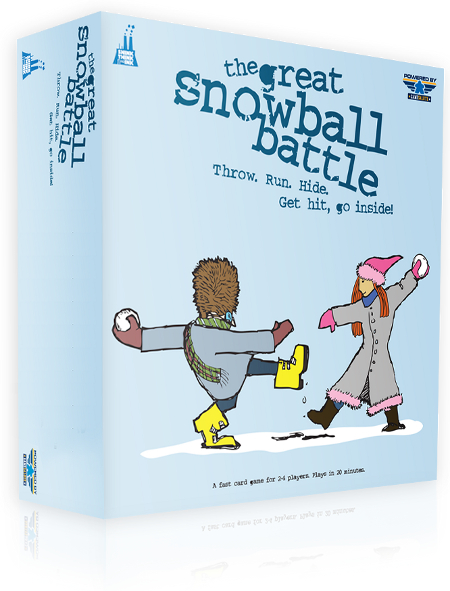
The Basics:
- For ages 7 and up (publisher suggests 8+)
- For 2 to 6 players
- Approximately 15 minutes to complete
Geek Skills:
- Counting & Math
- Logical & Critical Decision Making
- Reading
- Emotional Coping Skills
Learning Curve:
- Child – Easy
- Adult – Easy
Theme & Narrative:
- Put on your winter gear and get outside to participate in a neighborhood snowball fight!
Endorsements:
- Gamer Geek rejected!
- Parent Geek approved!
- Child Geek mixed!
Overview
As every child knows, when the snow starts to fall, the balance of power in the neighborhood begins to shift. The big kids down the street no longer have total control over the playground and the roving bicycle gang can no longer patrol the tennis courts. Every boy and girl is drafted to help fight for one cause or another. Grab a snowball and wage a cold war like only kids know how to do.
The Great Snowball Battle, designed by Matthew Link, Jason Snape, and published by Game Salute, is comprised of 61 Snowball cards, 22 Location cards, 22 Item cards, 18 Gear cards, and 10 Kid cards. The game also includes several blank cards to allow the game owner to customize their game, and 3 card deck holders that can be used to store the game cards if preferred. The cards are as durable as your standard playing card and have simple illustrations. Artist Jason Snape did a good job of portraying what the card is meant to represent with each illustration, making it easy to quickly glimpse at cards and know what you have.
Bundling Up to Go Outside
To set up the game, first shuffle the Snowball deck and place it face-down in the middle of the playing area.
Second, shuffle the Item and Location decks separately and place each to either side of the Snowball deck, face-down. Make sure to leave room for a discard pile for all 3 decks.
Third, either randomly deal or allow each player to select 1 Kid card and 3 Gear cards. Once selected or dealt, they are placed in front of their owning player, face-up. Place the Kid and Gear cards not used to one side of the gaming area.
Fourth, have each player draw 1 Location and 1 Item card. These cards are placed in-between the player’s Gear cards and the 3 draw decks, face-up. Leave room next to the Location cards for a discard pile that will contain thrown Snowball cards.
Fifth, each player draws 2 cards from the Snowball deck. If an “Event” Snowball card is drawn, it’s shuffled back into the Snowball deck. Each player should now have 2 cards in their hand.
That’s it for game set up. Let’s have a snowball fight!
The Kids on the Block
At the beginning of the game, each player was either randomly dealt or allowed to select 1 Kid card. Each Kid card lists a special ability that can be used once per game. When it’s used is up to the player. When the special ability is used, the Kid card is flipped face-down.
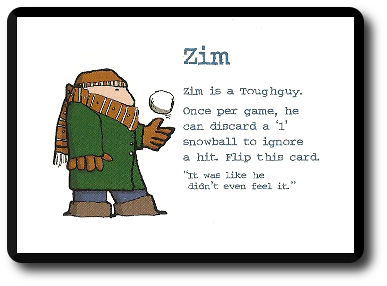
Ready? FIGHT!
The Great Snowball Battle is played in turns with no set number of turns per game. On a player’s turn, they will take 1 of 3 possible actions. Each of the actions is summarized here.
Note: If at anytime a player has less than 2 cards in their hand, they immediately draw another card to maintain a hand size minimum of 2 cards. Players can only draw from the Snowball deck in the middle of the playing area. If the player is drawing cards and draws an “Event” Snowball card, the game temporarily pauses and the Event is resolved. The game then resumes and the player continues to draw cards until they have a minimum of 2 in their hand.
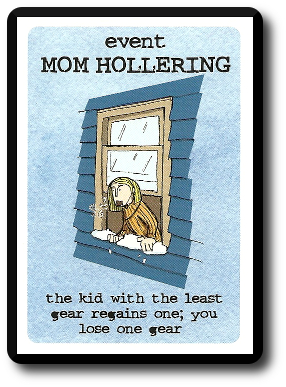
Optional Action One: Throw
For this action, the player chooses a “Snowball” or a “Quick Shot” Snowball card from their hand and sets it next to an opponent’s Location card, face-up. If other Snowball cards have been played at this location, the player places their card on top of the stack. When stacked, all the Snowball card number values should be visible. “Snowball” Snowball cards are the most common weapon the player will have at their disposal.
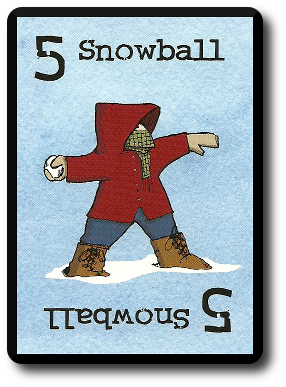
The “Quick Shot” Snowball cards are a special variety of snowball. They can be used like a normal snowball or as a special response to a specific Snowball card value. “Response” is a keyword that identifies cards that can be played out-of-turn by the player when a specific condition has been met. Response cards can also be found in the Item card deck.
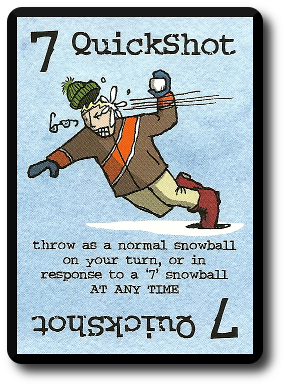
Players can also attach an Item card that modifies their snowball. These are placed in the stack with the “Snowball” or “Quick Shot” card. The Item card will describe how it can be used and has the keyword “Modifier” listed on them.
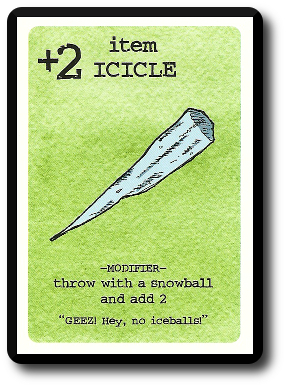
Optional Action Two: Clear Out
If the player is unlucky enough to be behind a Location that is about to fall under the weight of many, many snowballs, it’s time to find a new location before they get hit. To Clear Out and move to a new Location, discard the in play Location, Snowball, and Item cards in front of the player. Then draw 1 Location and 1 Item card, placing these in front of the player, face-up. All Gear and Kid cards remain as they are.
Optional Action Three: Use Actionable Item
Some Item cards have the keyword “Action” listed on them. These can be used on the player’s turn as their action. Once they are used, the Item card is discarded. A new Item card is not drawn to replace it.
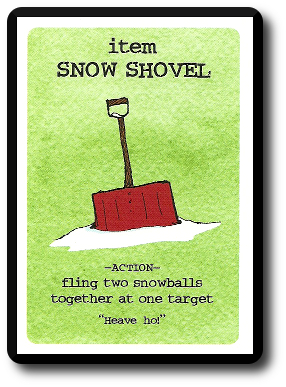
Some Item cards also have the keyword “Response” listed on them. These Item cards can be played out of turn by the player in response to an action taken by an opponent. Once they are played, they are also discarded.
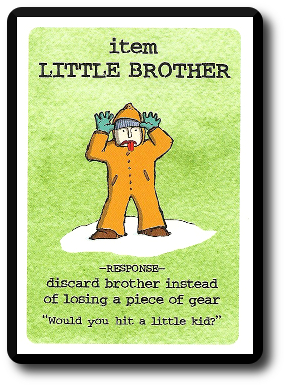
Some Item cards also have the keyword “Condition” listed on them. These Item cards remain in play and active until discarded or removed. One of my personal favorites is the “Snowhead” Item card that gives you extra protection at the “Headless Snowman” Location card.
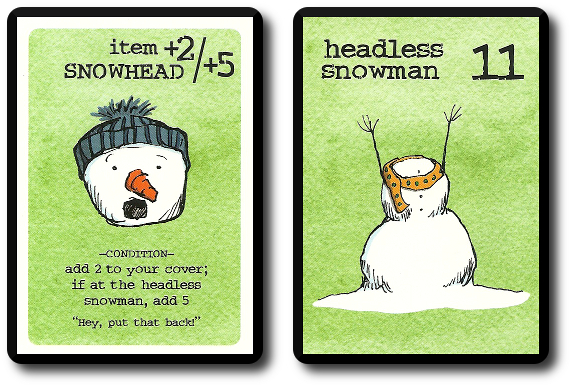
Note: Players won’t get a new Item card until they take the Clear Out action.
After the player takes their turn, it’s now the next player’s turn going in turn order sequence.
Snowball Sandwich TO THE FACE!!!!!
“Snowball” and “Quick Shot” Snowball cards, with our without an Item modifier card, have a number value. All the numbers in the stack are added together. If the total value is ever EQUAL TO or GREATER than the Location card value, the player who is hiding by the location is in trouble.
If a player is not lucky enough to be able to take the Clear Out action on their turn, every Snowball card that is placed in the player’s location counts as 1 hit. For every 1 hit, the player flips over 1 Gear card. If any player ever flips over their third Gear card, they are out of the game. Thematically, they have lost too many pieces of clothing and their mother wants them inside.
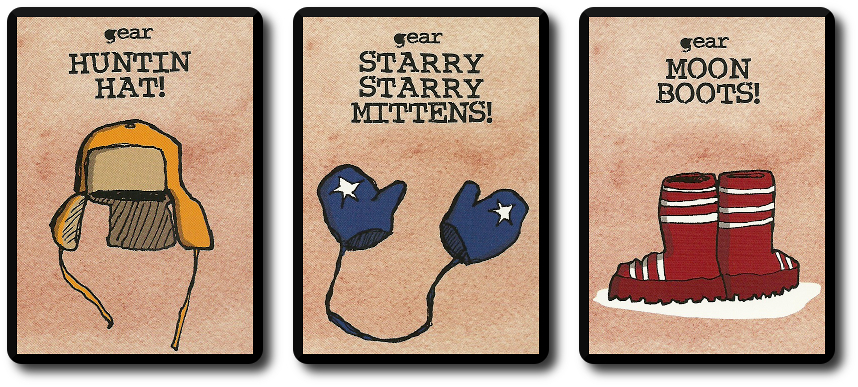
My 5-year-old wears this exact outfit in the winter…
Note: It’s perfectly possible to be dealt 3 Gear cards that do not make up an entire outfit. For example, 2 boots and 1 hat. What piece of clothing the Gear card represents is not relevant to the game play.
Winning the Cold War
The game continues until only 2 players remains. Out of the 2 remaining players, the one with the most Gear cards left wins the game.
Game Variants
When Playing with 2 Players…
When only playing with 2 players, there are a few rule changes.
- No player may Clear Out twice in a row.
- A player must throw at least 1 snowball before clearing out again
- The first player to lose all their gear loses the game
When Playing with 5 or 6 Players…
When playing with 5 or 6 players who are looking for a snowball fight, the follow rules change.
- When a player is hit, they are forced to immediately clear out before being hit again
House Rules
It does not explicitly state in the rule book, but players need to do a lot of table talking in order to make this game work and give the players a chance to win the game. Players must form alliances and cabals on the snowball strewn battlefield if they are to survive long enough to attempt to win. Table talking allows players to make promises, harass others, hurl insults, and make empty threats. All of which are common and encouraged in a real snowball fight.
To learn more about The Great Snowball Battle, visit the game’s web page.
Final Word
The Child Geeks weren’t exactly left cold after playing The Great Snowball Battle, but not everyone warmed up to it, either. The problem, as the Child Geeks saw it, was that some of them were being picked on. It was all good and fun until the Snowball cards started piling up. Depending on how quickly the Child Geek was able to Clear Out, they were oftentimes kicked from the game. According to one Child Geek, “I like it when everyone fights everyone. I don’t like it when everyone picks on one person.” Another Child Geek said, “This is just like a real snowball fight, including being sent home.” All the Child Geeks agreed on two things. First, that the game was easy to learn and fun to play. Second, they hated it when they were ganged up on. When all the votes were counted, the Child Geeks gave the game a mixed level of approval, which I think is more reflective of how the Child Geeks felt about individual games versus the game as a whole. One thing is certain and especially important for Parent Geek, this is a game where players can be targeted repeatedly. That feels like an attack to some Child Geeks and no one likes to feel attacked.
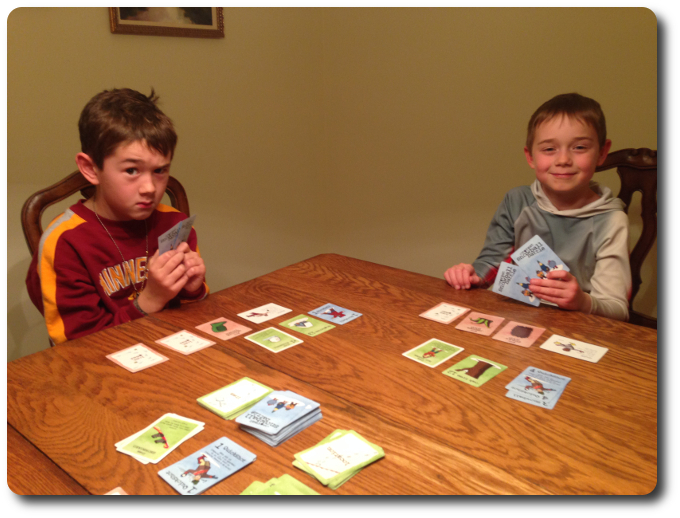
And then I jokingly said, “Good thing we’re all friends, right?” Oh..I’m dead…
The Parent Geeks didn’t like being attacked anymore than the Child Geeks (Parent Geeks are just big versions of Child Geeks, after all), but they didn’t let it get to them, either. This is a game of opportunity and alliances are made and broken in a blink of an eye. One Parent Geek said, “The only problem I have with this game is that you cannot stop players from targeting a single individual.” Thematically, it works in the game, but the Parent Geek has a point. Another Parent Geek said, “This is a brilliant little game. It’s light, easy to play, and fast. Reminds me of when I was a kid, except we put rocks in our snowballs.” Yikes. The only time the game didn’t seem to work was when the Parent Geeks played with their Child Geeks. As expected, the Child Geeks ganged up on the Parent Geeks, while the Parent Geeks pulled their snowball punches by evenly distributing their shots. Of course, the Parent Geeks didn’t survive. The best games were comprised of Parent Geeks, Gamer Geeks, and know-it-all teenagers. It was a slaughter. When all the games were over, the Parent Geeks voted to approve The Great Snowball Battle.
The Gamer Geeks thought the game was a good example of a game filler. It was certainly light enough and could sit enough people to keep everyone occupied before the “main game” was played. But the game itself wasn’t that impressive to the gaming elitists. One Gamer Geek said, “I think this game would be fun with kids or casual players, but this kind of game drives me nuts. I’m just smacking people left and right while I get smacked. The game is about outlasting, not out playing. No thanks.” Another Gamer Geek said, “An interesting take-that kind of game, but playing it once was enough for me.” What the Gamer Geeks liked was the unique theme and the game’s humor. The game also generated some nostalgia and there were a number of Gamer Geeks who told some crazy stories about their childhood in the winter (which I promised not to print). But the game itself did not win them over. The Gamer Geeks voted to reject The Great Snowball Battle.
This is a fun “take-that game” with the right crowd that is easy to teach and easy to play. It doesn’t take long, either. This game is really nothing more than a contest to see who can out last each other with very little in the way of skill, tactics, or strategy making any difference. The weak Locations get pegged hard and the players with the least amount of Gear are continually targeted. Feels unfair at times, especially to the Child Geeks, but I have no memory of any snowball fight I participated in feeling “fair”. And therein lies what I like most about this game. It feels like a snowball fight with a bunch of snotty nosed little kids who clearly are out for themselves in a very vicious snowball battle. No favoritism, no mercy, and absolutely no place for the weak.
Overall, I found the game to be so-so, at best. It was fun to play once or twice, but I quickly lost interest, as did most adults. But I didn’t get the impression that The Great Snowball Battle was meant to be played more than a few times. The “Event” Snowball cards and Kid variable abilities alter each game a bit, but there isn’t much differences between one game and the next. In short, it gets old. You are, after all, just playing cards to different piles. Thematically, everything is working like a charm. Game play wise, it kind of runs together and starts to feel repetitive.
So does that make The Great Snowball Battle a bad game? Hardly. It’s just a very simple game. Simple, but not easy. If players want to gang up on you, you’re toast. The winner of each game is the player that kept under everyone’s radar, joined the right groups, avoided the messy disputes, and never let their opponents see them coming. There’s a lot of cunning in this game, with subtle undertones of how brutal childhood can really be. The Great Snowball Battle is a game that everyone will enjoy playing once or twice, but not a game everyone will keep wanting to play.
Finally, I would like to leave you with this. No game that deals with kids, snowballs, and snow would be complete without a little yellow snow. The Great Snowball Battle has such a card. It’s an “Event” Snowball card, to be exact, and it always makes players smile when it’s drawn. It’s something everyone can relate to and be grossed out by, from the littlest of Child Geeks to the most venerable of Gamer Geeks. And for those of you who don’t get much snow I leave you with this small bit of advice: “Don’t eat the yellow snow. It doesn’t taste like lemonade”.

This game was given to Father Geek as a review copy. Father Geek was not paid, bribed, wined, dined, or threatened in vain hopes of influencing this review. Such is the statuesque and legendary integrity of Father Geek.



